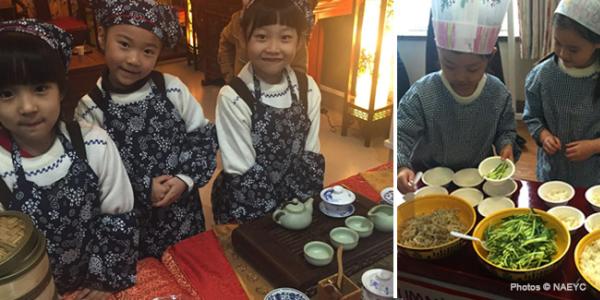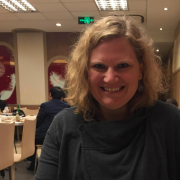Chopsticks or Forks: Contextualizing Developmentally Appropriate Practice in a Global Age

During a recent trip to spend time with early childhood professionals in China, I worked to master the skill of eating with chopsticks, and I was amazed by how much I had to learn. While I was no stranger to chopsticks—in fact I’m quite proud of my ability to use them when eating sweet and sour chicken in DC—it struck me how, in China, my use of chopsticks took place in an environment in which I worked to finesse this skill at an entirely new level. I learned to grasp the food more precisely as it circled by on the customary rotating round table that supports communal sharing of a meal. This was not just about my practicing the skill, but also about the influence of the place and the culture in which I was immersed—an illustration of the importance of context in learning. Joining my hosts in traditional Chinese meals and enveloped by the sounds of Mandarin, I became assimilated to my environment and worked to meet the expectations of the group. A process not so different from that of young children’s development.
High-quality early learning experiences provide children with opportunities to develop both physically and socially through authentic learning situations, including play. The settings in which children practice new skills work best when the environment reflects the individual child, family, and community. These core considerations, combined with what we know to be true about human development, are what we call developmentally appropriate practice.1 The myriad examples of how these considerations are implemented in early childhood classrooms demonstrate their power to joyfully engage young children in mastering new skills. Whether it be pairs of children engrossed in a game of Shagai (a traditional game using ankle bones) in Central Asia or a group of girls and boys role-playing the process of cooking and serving Arabic coffee in Saudi Arabia, context provides a vital foundation.
During my career, I have had the privilege to observe early childhood professionals in action in more than 30 countries, due most recently to my role directing global initiatives for NAEYC. Grounded in Vygotsky’s theory of social-cultural development—which posits that social interaction and community create meaning in the acquisition of knowledge—I understand the deep effect culture has on learning, and I value individual approaches to learning.2 However, individualized learning requires variances that at first glance might seem contradictory to Western expectations for children’s learning and development. The tension between my culturally based knowledge and expectations about child development and the realities of child rearing and teaching in other cultures are at the crux of what I love about learning. For me, a great example of this is what I learned in Central Asia about the ability of toddlers to successfully use the toilet. Coming from a culture where “potty training” is a significant topic of conversation and much time is devoted to this learning process, I could not fathom the ease with which young children monitor their body’s cues themselves, without a big production being made. And yet, born out of the necessities of a low-resource context, children’s mastery of this skill took place in a developmentally appropriate manner. Such examples remind us of how careful we must be to not create absolutes in judgement.
Sometimes the congruent differences—those things that are different but also the same—between cultures are simple to identify. For example, daily processes such as eating with chopsticks or forks are remarkably alike yet different. The tools vary yet the results are the same. Often, however, these kinds of differences are more subtle. For example, cultures vary in their expectation that preschoolers play outside regardless of weather. In the Baltic States young children joyfully engage in outdoor learning in twilight and freezing temperatures, surrounded by snow—something many in the US might find extreme. While there is a desire for an early learning blueprint that will guarantee certain outcomes across cultures, we can only provide a framework for quality and guidance to support practical application. True high-quality and engaged learning happens when developmentally appropriate learning activities aimed at teaching core skills—fine motor skills, for instance—are implemented through activities (eating with forks or with chopsticks) that make sense within each unique cultural context.
To recognize and value the unique experiences each child brings to the learning community and identify how each experience represents developmental achievement is an art. An art that demands deeply knowledgeable professionals to facilitate the continuing acquisition of higher-order skills while maintaining the nuances of each child’s individual reality. NAEYC’s own definition of developmentally appropriate practice has evolved since first published in 1986. As the world increasingly becomes smaller and opportunities for shared learning grow, I look forward to observing the impact of citizenship in a global community on practice as we adopt new ways to support optimal development for young children.
References
1Copple, Carol, and Sue Bredekamp. Developmentally appropriate practice in Early Childhood Programs Serving Children From Birth Through Age 8. Washington, DC: National Association for the Education of Young Children (2009).
2Berk, Laura E., and Adam Winsler.1995. Scaffolding Children's Learning: Vygotsky and Early Childhood Education. NAEYC Research Into Practice series, vol. 7. National Association for the Education of Young Children, 1509 16th Street, NW, Washington, DC 20036-1426 (NAEYC catalog #146).
Stephanie Olmore serves as NAEYC’s senior director of global engagement. Since working as a student assistant in a campus child care program 20 years ago, she has held a variety of policy and evaluation roles, including leadership positions in NAEYC’s Academy for Early Childhood Program Accreditation. Her dedication to high-quality early learning has taken her to more than 30 countries.
